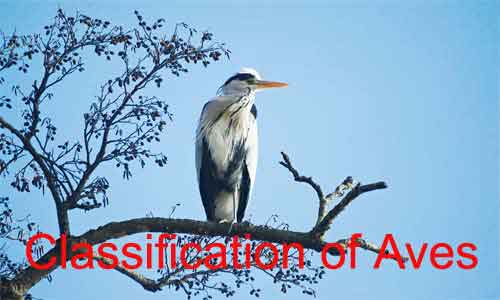Aves is a class of vertebrates that comprises the birds’ species. Birds are bipedal, feathered, and endothermic egg-laying animals. They are found worldwide, and their size ranges from 5 cm (bee hummingbird) to 2.75 m (ostrich). Among the tetrapod classes, birds constitute the largest number of species. There are about 10,000 living modern bird species in the world that occupy nearly all habitats on Earth.
Characteristic Features of Class Aves
- The body of the most bird is spindle-shaped, and it is covered with different types of unique structures, feathers for the most part.
- Forelimbs are modified as wings for flight, and the posterior hind limbs are adapted for walking, perching, wading, or swimming.
- Only legs are covered with scales, usually with four toes on each foot.
- The birds’ bones are fully ossified and pneumatic or hollow inside, which lower the overall weight of the body.
- Uropygial or oil gland is present in the tail region.
- The mouth is wide, and jaws are covered by horny sheaths that form strong beaks.
- Teeth are not present in the mouth. In this case, food is swallowed unmasticated.
- The alimentary canal leads to the cloaca. Alimentary canal often contains additional chambers like crop and gizzard. In this case, the crop stores and softens food while the gizzard is muscular to crush and stir up the softened food.
- Some bird species, such as pigeon, keep stone in the gizzard to effectively crush grains and seeds.
- Birds are adapted to various modes of feeding due to the modified structures of beak: fruit-scooping, seed-crushing, fish-tearing, wood-chiseling, nectar-sipping, grain-pickling, etc.
- The skin is thin, loose, and dry with flight muscle in the thorax; the sweat gland is absent.
- The head is small and round with a relatively long, flexible, and movable neck.
- They have no urinary bladder.
- They have a four-chambered heart with two ventricles and two atria.
- The respiratory system can perform double respiration. In this case, air sacs are connected to the lungs, which ensure supplement respiration.
- They have small, elastic type lung, which is affixed in the dorsal wall of the thorax and give rise to some air-sacs to increase its efficiency.
- The kidney is the excretory organ, which is metanephric, urine is semi-solid.
- They have relatively large-sized eyes which powerful with a specialized structure known as pectin.
- Birds perform internal fertilization.
- They are oviparous, and the matured female lay eggs with a large amount of yolk (telolacithal).
- Development is direct, and four embryonic membranes such as amnion, chorion, allantoin, and yolk sac are formed.

Pets Deluxe Critter Nation Double Unit Small Animal Cage
Details classification of Class Aves with distinguishing characteristics and examples are described below:
Subclass-1: Archiornithes
[Gk. Archios = ancient + ornithos = bird]
- They were the most primitive and extinct fossil birds of the Jurassic period.
- The jaws did not bear teeth.
- Archiornithes had a long feathered tail.
- They had a reptile-like and elongated body.
- Forelimb had three clawed digits,
- They had a small brain and eyes.
- They had non-pneumatic bones and were capable less specialized for flight.
- They had a well-developed beak.
Subclass Archiornithes includes the following order:
Order-1: Archaeopterygiformes
- The tail was long with the distal tapering end.
- The forelimbs had remiges with three clawed digits.
- Head was large with proportionately large eyes.
- They had strong jaws with enameled crowned teeth.
- Cerebral hemispheres were smooth, long, and narrow with small cerebellum.
Examples:Archaeopteryx lithographica, Archaeornis siemensi.
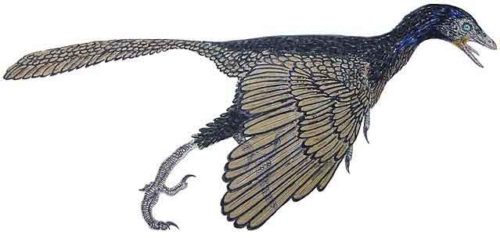

Archaeopteryx lithographica
Subclass-2: Neornithes
All the modern birds belong to the subclass Neornithes. This subclass contains about 10,000 known living birds’ species throughout the world. The representatives of this subclass first appeared in the Cretaceous period of the Mesozoic Era. This subclass also includes a few extinct birds.
- They have a well-developed sternum, which is usually keeled or carinate.
- They do not bear long tail with no teeth on both jaws. In this case, teeth are replaced by horny rhamphotheca over the bill, but extinct forms had teeth.
- The forelimbs become modified to wings.
The subclass Neornithes is further divided into the following four superorders:
- Superorder-1: Odontognathae
- Superorder-2: Palaeognathae
- Superorder-3: Impennae and
- Superorder-4: Neognathae
Superorder-1: Odontognathae
[Gk. Odontos = teeth + gnathos = jaw]
- They were the New World toothed birds. They were found in the Upper Cretaceous period of the Mesozoic Era (100.5 – 66 MYA).
- They had short tails with a plowshare-shaped pygostyle.
- They had a well-developed carina for flight muscle.
- Both jaws had teeth.
- They were flightless birds but were specialized for swimming.
- They had intramandibular articulation.
- Sternum did not bear keel and wings had vestigial humorous only.
Superorder Odontognathae is divided into the following orders:
Order- 1: Hesperornithiformes (extinct)
- They were extinct aquatic birds and inhabited in both freshwater and marine habitats in the Northern Hemisphere.
- They were flightless predatory divers with strong swimming behavior.
- They reached a maximum length of over 1.5 meters.
- They had a long neck with heterocoelous vertebrae.
- Forelimbs had vestigial humerus only.
- Both jaws had pointed teeth, but the premaxilla did not bear teeth.
- The hind limbs brought webbed feet.
Examples:Parahesperornis, Hesperornis, Enaliornis, Baptornis, Neogaeornis, and Potamornis.
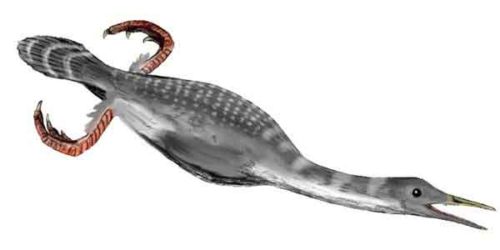

Order- 2: Ichthyornithiformes (extinct)
- The representatives of Order Ichthyornithiformes were small-sized marine flying birds, of Upper Cretaceous of North America.
- They found throughout the late Cretaceous period (80–65 million years ago) of North America.
- They became extinct at the Cretaceous–Paleogene boundary.
- They had amphicoelous vertebrae in the neck region.
- They had a well-developed keel in the sternum with fused clavicles.
Examples:Ichthyornis, Apatornis
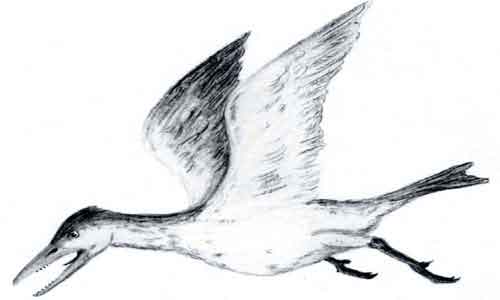

Superorder-2: Palaeognathae
- Superorder Palaeognathae contains 47 species, of which, three cassowaries (Casuarius), five kiwis (Apteryx), 1 emu (Dromaius), two ostrich (Struthio) and two species of rheas (Rhea).
- Most of the birds are flightless. In this case, some anatomical features are associated with flightlessness. These include reduced keel on the sternum, reduced wing bones, etc.
- All species of tinamous can fly, but they are very terrestrial.
- During reproduction, the male provides parental care.
- The males have an erectile penis and the females with the clitoris.
- They show unusual mating system such as polygynandry/promiscuity.
- They have primitive types of feathers that do not bear hooked barbules.
- The rectrices or flight feathers are absent or irregularly arranged.
- They have small or poorly developed pygostyle.
- Wings are absent; if present, they are vestigial or reduced in size.
- The flat, raft-like sternum is present.
The superorder Palaeognathae includes the following seven orders (of which two are extinct).
Order- 1: Struthioniformes
[Gk. Struthio = Ostrich + form]
- They are the largest flightless, running birds found in Africa and Arabia.
- Struthioniforms can reach up to 210 cm in length and 170 kg in weight.
- They inhabit arid lands forming a flock of 3-20 birds.
- The members of Struthioniformes bear degenerated breast muscles with no keel of the sternum.
- Legs are strong and the leg bones without air chambers.
- The flight and tail feathers are converted to decorative plumes.
- The uropygial gland or preen gland is absent.
- All are omnivorous and feed on all types of food.
- Wings are small, which usually kept folded during running.
- The head, neck, and leg bear feathers sparsely.
- Feathers do not contain aftershaft.
- Tail feathers are put back by tail coverts.
- They have strongly build hind limbs, and each foot bears only two toes.
- The pygostyle is absent, and the sternum does not contain keel.
- During the breeding season, the female lays up to 30 eggs.
Example: Common ostrich, or simply ostrich (Struthio camelus)


Order- 2: Rheiformes
[Gk. Rhea = mother of Zeus + form]
- Rheiformes are large flightless running ratite birds native to South America.
- They inhabit groups of a variety of open areas, such as grasslands, savanna, or grassy wetlands.
- They can live up to 10.5 years and can reach about 120 cm tall with a weight of 23-25 kg.
- During the breeding season, the male builds a nest, and the female lays her eggs in the nests.
- The male incubates the eggs for about 40 days.
- All members of this order are omnivorous and prefer to eat broad-leafed plants. They also eat seeds, fruit, roots, insects, and small vertebrates.
- Each foot bears three front toes, which are webbed at the base.
Examples:Rhea americana, Pteronemia pennata.
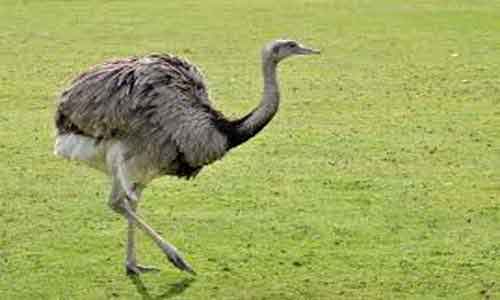

Order-3: Casuariiformes
- Casuariiformes are large, flightless terrestrial birds native to Australia.
- This group includes the emus and cassowaries. In this case, the emus can grow up to 1-8 meters in height and 55 kg in weight.
- They are large and heavy birds, while the females are usually slightly larger than males.
- Legs are long and robust while the head is relatively small, and the neck is long.
- The plumage is usually brown in color while the head is naked, and the neck is blue in color in emus and orange/red in cassowaries.
- They have no differentiated tails or tail feathers.
- Hair-like feathers with no barbules.
- The foot is three-toed of which, the middle toe on both legs bear an elongated and dagger-like claw.
- The wings are modified into five hollow spines.
- The birds do not build a nest, and the female lays her eggs into depression in the grass.
- The male incubates the eggs as well as care for the young hatchlings.
- The baby birds reach maturity within two years.
- They are aggressive birds and prefer to live in tropical rainforests. In this case, emus inhabit in different conditions, from forest to grasslands.
- All are herbivorous and prefer to feed on fruit, seeds, and grasses.
Examples:Dromaeus novaehollandiae (Emu), Southern cassowary (Casuarius casuarius).
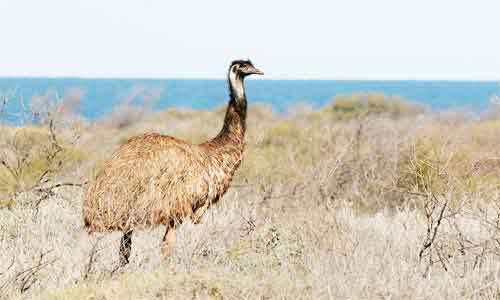

Order- 4: Apterygiformes
- Apterygiformes are flightless birds endemic to New Zealand.
- The birds are pink, brown, and grey in colors.
- The body is small pear-shaped with vestigial wings and small eyes. In this case, wings are about 4-5 cm long, and each wing has a claw that hidden in the plumage.
- They have robust legs and feet. In this case, each leg contains four-clawed toes.
- The beak is long, flexible, which is downward curved at the end with a thick and horny tongue. In this case, the beak also contains nostrils at the tip.
- The plumages are feathery, hair-like with a soft base that does not contain after shafts. In this case, juvenile bears softer feathers than the adult.
- They prefer to live in rainforests, but they can also be found in grasslands, shrubs, and pine forests.
- Apterygiformes are omnivorous and prefer to feed on earthworms, beetles, larvae, fruits, and leaves.
- They are monogamous birds: during the breeding season, they make burrows into the soil or use natural holes and caves as nests for laying eggs.
- The matured female lays one or two eggs, and the female incubates the eggs until hatching. In this case, both males and females take care for their hatchlings.
Examples: Southern Brown Kiwi (Apteryx australis), North Island Brown Kiwi (Apterix mantelli), Great Spotted Kiwi (Apteryx haastii), Okarito Kiwi (Apterix rowi). Little Spotted Kiwi (Apteryx owenii), etc.
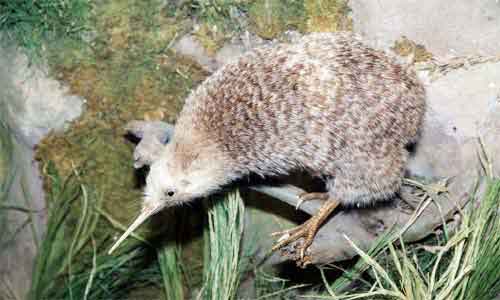

Order- 5: Dinornithiformes (extinct)
- Dinornithiformes were flightless running birds, commonly called Moa, endemic to New Zealand. They are now extinct.
- They reached about 3.6 meters in height and 230 kg in weight.
- The body was covered by feathers with large after shafts and without barbicels.
- The beak was short, and the hind limbs had four toes.
- Sternum was un-keeled.
Examples:Dinornis robustus and Dinornis novaezelandiae
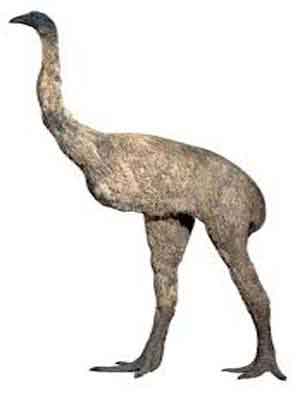

Order- 6: Aepyornithiformes (Extinct)
- Aepyornithiformes are the extinct large to enormous flightless birds, also known as giant flightless Madagascar elephant birds.
- They reached up to 9.8 feet in height and 500 kg in weight.
- They had relatively tiny wings and stout, powerful legs with four toes.
- They became extinct since at least the 17th century due to human activities.
- Their egg length was up to 34 cm and weight 1o kg with volume up to 2 liters. It was 160 times larger than a chicken egg.
Examples:Aepyornis maximus, A. hildebrandti, A. medius, A. gracilis, Mullerornis agilis, M. rudis, M. betsilei, etc….
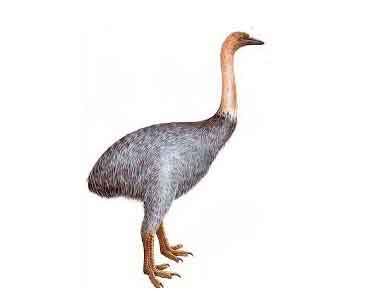

Order-7: Tinamiformes
- The order Tinamiformes contains 47 species in nine genera under the family,Tinamidae; found in Southern Mexico and Central and South America.
- They are cursorial birds commonly known as Tinamon, which can fly over a short distance. They are also able to walk and run rapidly.
- They inhabit a wide variety of habitats, such as tropical rain forests, scrubby woodlands, forest edges, arid or semi-arid grasslands, etc.
- The body is heavy chicken-like, and the coloration of plumage ranges from light or dark brown to gray. Some have dark-spotted or barred patterns.
- The neck is long slender with a small head and thin decurved bill.
- The body reaches up to 50 cm in length and 2kg in weight.
- The leg is medium long with short wings and tail.
- The legs bear three short toes and one backward pointed toe.
- The skeleton is pneumatic with a carinate sternum.
- The uropygial gland is small and tufted.
- All birds are omnivorous and prefer to feed on seeds, fruits, roots, insects, termites, spiders, ticks. Some also feed on small vertebrates like lizards, mice, frogs, etc.
- During the breeding season, they build a nest in the ground near the base of grasses or trees.
- The matured females lay 3-4 eggs, and the male incubates the eggs for 17-21 days.
- After hatchings, the young, parents provide care for one to two months..
Examples: Barred tinamou (Crypturellus casiquiare), Bartlett’s tinamou ( Crypturellus bartletti).
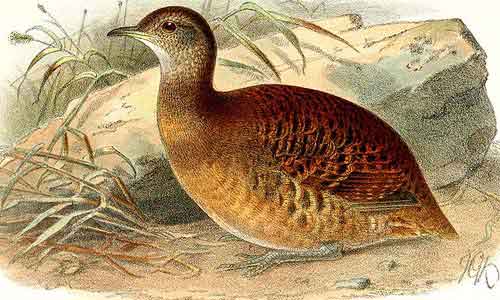

Superorder-3: Impennae
They are flightless aquatic birds. Their forelimbs are modified into paddles, which are used for both swimming and flight. This superorder includes only one order.
Order: Spheniseiformes
[Gk. Spheniscus = wedge + form]
- Spheniseiformes are flightless aquatic birds, which belong to the family, Spheniscidae, commonly known as penguin, found southern part of South America, South Africa Australia, Antarctic regions and Galapagos Islands.
- The body is medium to large which can grow up to 115 cm in height and 40 kg in weight.
- The plumage of adult birds is blue-black or gray dorsally and white ventrally.
- They have either entirely brown–gray or white ventrally chicks.
- The feathers are small, scale-like, and continuous.
- Long and often laterally compressed bills are present.
- The skeleton is poorly pneumatized with the carinate sternum.
- The wings are modified to form flippers.
- The legs are short, which are placed far posterior on the body.
- They have palmate feet, which are strongly webbed with pointing toes.
- Hind limbs are modified for swimming.
- The oil gland is present, which is tufted.
- They are monogamous, and the mature female lays only one egg at a time.
- All birds are carnivorous and mainly feed on fishes, crustaceans, squids, etc.
Examples: Emperor penguin (Aptenodytes forsteri), Adélie penguin (Pygoscelis adeliae), Crested penguin (Eudyptes calauina), Little penguin (Eudyptula minor), Magellanic penguin (Spheniscus magellanicus), etc.


Superorder-4: Neognathae
The word “Nognathe” is derived from Greek ‘neo’ meaning new and ‘gnathos’ meaning jaw. This superorder includes all modern living birds with nearly 10,000 species.
- Neognathae have well-developed wings which are fully adapted for flight.
- The beak does not contain any teeth.
- The forelimbs have fused metacarpals with an elongated third finger.
- Pygostyle is absent, and the tail is composed of 5-6 vertebrae.
- The sternum is well-developed with the keel.
- Rectrices are organized in a semicircular manner, which helps in flight.
- They have a neognathous type skull where the palatines are protruded posteriorly and come in contact with the base of the cranium.
Superorder-Neognathae is divided into the following orders:
Order-1: Gaviiformes (Loons)
- The order Gaviiformes contains five living species, and all are placed in the genus Gavia under one family, Gaviidae.
- They are medium to large-sized aquatic birds.
- They are also known as Piscivorous sea or lake-birds found in North America, Europe, and the Arctic.
- They are adapted for diving and swimming.
- They can also be able to fly.
- The legs are short with webbed toes.
- The bill is sharp and dragger-like.
- Their size ranges from 20.8–35.8 in (53–91 cm) with 1.0–6.4 kg in weight.
- The males are slightly larger than the females.
- They inhabit forested and tundra lakes and ponds, but in the winter season, they inhabit at sea and large reservoirs.
- During the breeding season, plumage becomes boldly patterned primarily with black, white, and gray, while the non-breeding plumages are drab gray-brown and white.
- The eyes have a brilliant red iris.
- All birds are carnivorous and mainly feed on fish and crustaceans.
- The neck is long with short wings.
- The matured female lays eggs in a nest among piles of vegetation.
Examples:Gavia arctica and G. stellata
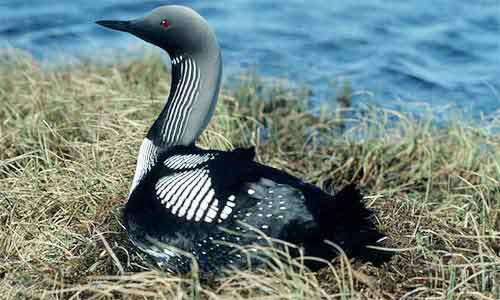

Order-2: Podicipediformes (Grebes)
- All the members of this order are also known as grebes.
- This order contains two species in 6 extant genera under one family (Podicipedidae).
- They are freshwater diving birds, distributed worldwide.
- The body is small to medium-large, which can grow up to 78 cm (31 inches) in length.
- They have little tails with degenerated feathers and silky plumage.
- They are excellent divers and swimmers.
- They dwell in ponds, lakes, and rivers.
- The bills are moderately long, while wings are short.
- The eyes are red, yellow, or brown.
- The legs bear lobed toes.
- They are carnivorous and feed on fish, crustaceans, aquatic insects, mollusks, and small vertebrates.
Examples: Great crested grebe (Podiceps cristatus), Western grebe (Aechmophorus occidentalis), Pied-billed grebe (Podilymbus podiceps), etc.
Order-3: Procellariiformes (Tube-nosed seabirds)
- The order Procellariiformes contains 117 species under four families, including the birds’ groups like albatrosses, shearwaters, and petrels.
- They are also known as tube-nosed seabirds distributed throughout the world.
- The body size can reach a length of 13–200 cm (5.1–79 inches) with a wingspan of more than 3 meters (10 feet).
- The beak is long hooked at the tip.
- The wings are long, narrow, and pointed.
- The foot is webbed with a strong hind claw.
- The tail is short and rounded.
- The plumages are oily and compact.
- Hind toe is vestigial or none.
- The plumage is compact and oily.
- During the breeding season, they come to land only and build-up nest in holes.
Examples: Leach’s storm petrel (Oceanodroma leucorhoa), Audubon’s shearwater (Puffinus lherminieri), common diving petrel (Pelecanoides urinatrix), slender-billed prion (Pachyptila belcheri), etc.
The order Procellariiformes includes the following four families:
- Diomedeidae
- Procellariidae
- Hydrobatidae
- Pelecanoididae
Order-4: Pelecaniformes (Waterbirds)
[Gr. Pelikan = Pelican + form]
- The order Pelecaniformes contains 66 species under six families, distributed worldwide, including the birds’ group like boobies, cormorants, tropicbirds, gannets, and frigate birds.
- The body is medium-sized and large, which varies from 19–74 inches (48–188 cm) in length.
- The leg is short with large webbed toes.
- The body is brown, black, or white in colors or a combination of those colors.
- The bill is hooked or straight with sharply pointed.
- The birds are carnivorous and mainly feed on fish. Some also take squid, crustaceans, amphibians, and reptiles, etc.
- They inhabit marine and freshwater habitats throughout the world.
- Most species of this order bear a bare gular pouch or throat pouch, which is situated between their lower jaws.
- They also bear a comb-like pectinate nail on their longest toe, which is used for brushing out and separate their feathers.
- The birds are monogamous, and during the breeding season, they build a nest where the mature females lay eggs. Both the female and male incubate the eggs and care for the babies.
Examples: Dalmatian pelican (Pelecanus crispus), Pygmy cormorant (Phalacrocorax pygmaeus), Red-footed Booby (Sula sula), Snakebird (Anhinga anhinga), Red-tailed tropicbird (Phaethon rubricauda), etc.
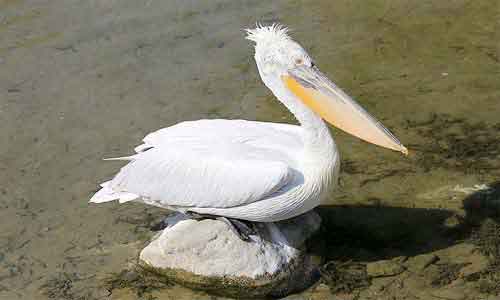

The order Pelecaniformes includes the following six families:
- Phaethontidae
- Fregatidae
- Sulidae
- Phalacrocoracidae
- Anhingidae
- Pelecanidae
Order-5: Ciconiiformes (herons, storks, Egrets, Flamingos and their allies)
[L. Ciconia = stork + form]
- The order Ciconiiformes includes 120 species under five families, found worldwide in tropical and subtropical areas, but storks and herons can also be found in more temperate regions.
- They are long-legged wading birds with medium to the large-sized stocky body, which reach a length of 9.7–60 inches (25–152 cm).
- They have a long slender, flexible neck with long straight, sharp, and dagger-like bills. In this case, new world vultures have bills with serrated edges for eating meat.
- Middle and outer toes of the feet are webbed at the base.
- The wings are large, with a usually short tail.
- The order Ciconiiformes includes both sedentary and migratory species. In this case, most of the birds form roots on trees where they return each year.
- Their food consists of fish, other aquatic animals, small mammals, and rarely seeds and fruits.
- During the breeding season, herons use their ornamental plumes for courtship.
- Most of the species build nests using sticks on trees, but only vultures do not build nests; they lay eggs in caves or under bushes.
- Both the male and female take care of the young.
- Most of the species of Ciconiiformes have combined color plumage, which may be grey, white, and black.
- Most of the representatives of this order settle in wetlands or shorelines of large bodies of water for searching their food
- Most species of the order are found in tropical and subtropical areas, though species such as storks and herons can be found in more temperate regions.
- The representatives of the order (except vultures) mostly settle in wetlands, sometimes search for food near shorelines of large bodies of water.
Examples: Great blue heron (Ardea herodias), Snowy egret (Egretta thula), Cattle egret(Bubulcus ibis), Shoebill (Balaeniceps rexi), Marabou stork (Leptoptilos crumeniferus), Jabiru (Jabiru mycteria), White Ibis(Eudocimus albus), Black vulture (Coragyps atratus), California condor (Gymnogyps californianus), Turkey vulture(Cathartes aura), etc.
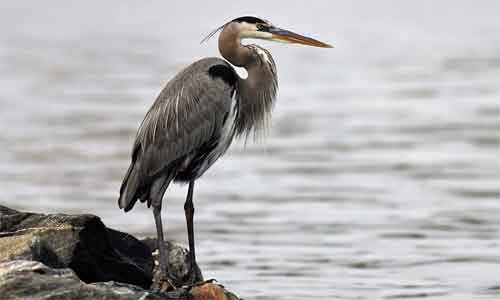

The order Ciconiiformes includes the following five families:
- Ardeidae
- Balaenicipitidae
- Scopidae
- Threskiornithidae
- Ciconiidae
Order-6: Anseriformes (screamers, waterfowl)
[L. Anser = goose + form]
- The order Anseriformes contain about 170 species under three families, namely Anatidae (ducks, geese, swans), Anseranatidae (Magpie Goose), and Anhimidae (screamers).
- The representatives of this order are called waterfowl birds because they inhabit near freshwater bodies such as ponds, lakes or other water-resource areas.
- They are large water birds having broad, flat bills with comb-like margins which are used for filtering food particles.
- The tail is short; wings are usually narrow and pointed. In this case, migratory species bear powerful wings that are adapted for flights long distance.
- The legs are short, sturdy having feet usually webbing between the toes, which are adapted for walking or swimming.
- The colors of the birds vary from black, grey, and brown to brighter coloring.
- The birds have medium to long neck.
- The food of Anseriformes consist of plants and their parts, such as leaves or seeds, insects, planktons or mollusks, etc
- Most of the Anseriformes are monogamous; during the breeding season, most species form the same pair from year to year. The matured ducks and swans females lay several eggs.
- The parents care for their young, and they watch over their feeding, flying, and swimming.
- The young hatchlings are well-developed and are usually able to see and walk almost immediately.
Examples: The mallard (Anas platyrhynchos), Coscoroba swan (Coscoroba coscoroba) , Canada geese (Branta canadensis) , Common eider (Somateria mollissima), , Muscovy duck (Cairina moschata), Steller’s eider (Polysticta stelleri), White-headed Duck (Oxyura leucocephala),etc.
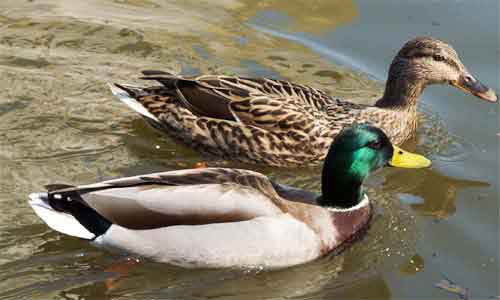

Order -7: Falconiformes (diurnal birds of prey)
[L. Falco = falcon + form]
- The order Falconiformes contains 309 species of birds under five families. The representatives of the orders include the bird groups like falcons, hawks, eagles, the secretary bird, vultures, and condors.
- The maximum length of the bids ranges from 14–150 cm (5.5–59 inches), having wingspan more than 10 feet (3 meters).
- The beak is short with longer upper mandible that is hooked at the tip for tearing flesh.
- Most of the birds of falconiformes have strong legs, which bear strong and powerful feet with hooked claws.
- They have well-developed sight and hearing with brown eyes (except eagles, who have golden eyes). In this case, eyes are laterally placed.
- Their food consists of living vertebrates such as fish and insects.
- Most bird species are monogamous. The matured females lay eggs and incubate it. The males take care and feed the females during the incubation period.
Examples: Peregrine falcon(Falco peregrines), Fox Kestrel (Falco alopex), Merlin (Falco columbarius),Common kestrel (Falco tinnunculus), Laughing falcon (Herpetotheres cachinnans), Lined forest falcon (Micrastur gilvicollis), Crested Caracara (Caracara cheriway), Spot-winged falconet (Spiziapteryx circumcincta), Pygmy falcon (Polihierax semitorquatus).


The order Falconiformes includes the following five families:
- Cathartidae,
- Pandionidae,
- Accipitridae,
- Sagittariidae,
- Falconidae
Order- 8: Galliformes (chicken-like birds)
[L. Callus = Cock + form]
- The Order Galliformes contains about 290 species under four families. The representatives of this order include birds groups like Game birds, Megapods, Hoatzins, Patridge, Turkey, Quail, Fowls, Guinea Fowl, Pheasants, Peacocks, guans and curassows, found nearly worldwide.
- The legs are stout, and un-feathered with strong clawed for scratching soil for searching food. In this case, three toes are anteriorly directed.
- Wings are short, rounded, and the feathers with long aftershafts.
- The length of the body ranges from 5.9 inches to more than 79 inches (15 to more than 200 cm).
- The feet have short, strong, and blunt claws.
- The members of Galliformes have short, strong, and arched beak suitable for picking up grains or seeds.
- Many representatives of the Galliformes have ornamental tails and bright crests.
- They have compact bodies with small-sized head.
- Males are aggressive polygamous and build mounds for incubating their eggs.
Examples: Great Curassow (Crax rubra), Rock ptarmigan (Lagopus muta), Rock partridge (Alectoris graeca), Common Quail (Cotumix cotumix), Common pheasant (Phasianus colchicus), Wild turkey (Meleagris gallopavo) , Hoatzin (Opisthocomushoazin), etc.
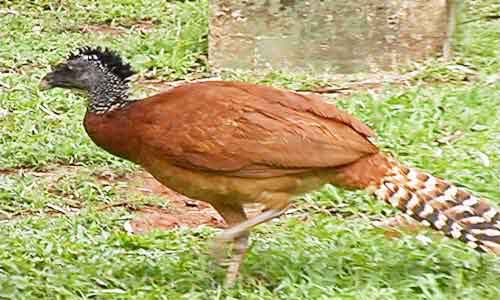

The Order Galliformes includes the following four families:
- Cracidae,
- Megapodiidae,
- Numididae,
- Phasianidae.
Order- 9: Gruiformes (cranes and their allies)
- The order Gruiformes contains about 210 species under11 families, found worldwide.
- Most of the birds have grey, white, or brown colors.
- The body length ranges from 4.7–70 inches (12–176 cm).
- Many members of the Gruiformes have long and strong legs with long, slender bills.
- The wings are long with rounded edges.
- Most of the birds feed on fish, mollusks, and reptiles.
- The power of fight is weak, and toes are slightly webbed.
- They are known for special mating rituals. They built a nest on the ground.
Examples: Common crane (Grus grus), Water rail (Rallus aquaticus), Eurasian or common coot (Fulica atra), Common moorhen (Gallinula chloropus), Kagu or cagou (Rhynochetos jubatus) , Common Buttonquail(Turnix sylvaticus), etc.


The order Gruiformes includes the following 11 families:
- Rallidae,
- Heliornithidae,
- Rhynochetidae,
- Eurypygidae,
- Mesoenatidae,
- Turnicidae,
- Gruidae,
- Aramidae,
- Psophiidae,
- Cariamidae,
- Otididae
Order -10: Diatrymiformes (Extinct)
- Diatrymiformes were large flightless birds of Europe and North America.
- They have been found in the Eocene period(55 to 65 MYA).
- They had massive head, neck, and beak.
- The birds were over two meters tall with large skulls.
- They weighed about 100 kg.
Example: Diatryma(Gastornis).
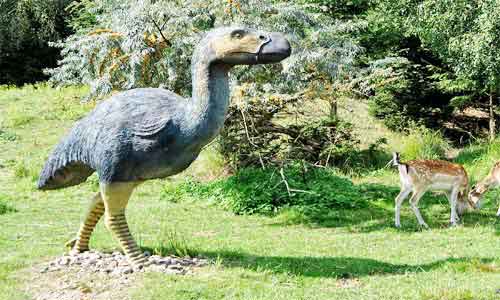

Order-11: Charadriiformes (gulls, sandpipers, auks, and their allies)
[L. Charadrius = Genus of Plovers + form]
- The order Charadriiformes contains 370 species under 17 families, including the bird groups like plovers, jacanas, stilts, avocets, thickknees, terns, and murres.
- The representatives of Charadriiformes have a cosmopolitan distribution.
- They inhabit near water; some live inshore, some in aquatic leaves while some are aquatic.
- They have more or less longer legs with only three toes. In this case, toes are usually webbed, at least at the base.
- The members of this order have firm and dense plumage.
- The length of the body ranges from 4.7–30.7 inches (12–78 cm).
- Shorebirds search their food in mud, sand, or shallow waters.
- All birds are usually carnivorous and feed on fish, invertebrates, or other small animals in mud or water.
- Beak is variously modified, hallux small or absent.
Examples: Kentish plover (Charadrius alexandrinus), Wattled jacana( Jacana jacana), Australian Painted-snipe (Rostratula australis), Eurasian oystercatcher (Haematopus ostralegus), Northern lapwings (Vanellus vanellus), Whimbrel (Numenius phaeopus) , Collared pratincole (Glareola pratincola), Western gulls (Larus occidentalis) , Atlantic puffin (Fratercula arctica), etc.
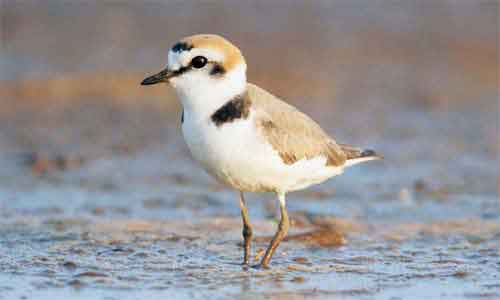

Order-12: Columbiformes: (pigeons and doves)
[L. Columbia = a dove + form]
- The order Columbiformes contains over 300 species under one family(Columbidae), found worldwide.
- The length of the body ranges from 5.9–47.2 inches (15–120 cm).
- They are fast-flying birds having slender and short bills.
- The wings are long, pointed, which help the birds to make a sustained flight at a great speed.
- The base of the beak is covered by soft skin, having longitudinal slit-like nostrils called cere.
- The head and neck are small and compact.
- The legs are small in size, with all the toes lie down in the same plane.
- The members of this order bear large crop which can produce pigeon milk during the breeding season.
- They are monogamous, and the matured female lays 2-3 eggs.
- Both males and females incubate the eggs, and the female nourishes the young with the help of ‘pigeon milk’ produced by both sexes.
- They are herbivorous and feed on seeds and fruit.
Examples: Pin-tailed sandgrouse (Pterocles alchata), Eurasian collared dove (Streptopelia decaocto), Rock pigeons (Columba livia), Little green pigeon (Treron olax), Tooth-billed pigeon (Didunculus strigirostris), etc.
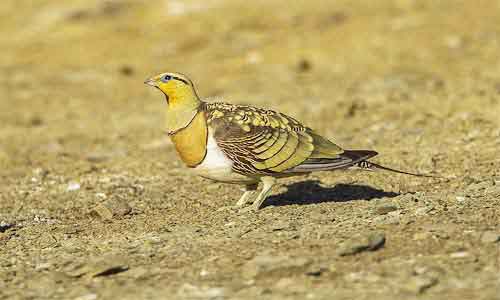

Order-13: Psittaciformes (parrots, lorikeets, cockatoos, kea, and kakapo)
[L. Psittacus = Parrot + form]
- The order Psittaciformes contains 369 species under 2 families (Psittacidae, Cacatuidae).
- Psittaciformes are omnivorous, and they feed both meat and vegetation. Their food consists of flowers, nuts, fruit, seeds, buds, and insects, etc.
- The Psittaciformes have brightly colored plumage. Most of the birds bear green feathers, and many have blue, red, and yellow colors.
- They have a sturdy body, and the length of the body ranges from 3.2–39 inches (8–100 cm). Red-breasted pygmy parrot reaches up to 3.3-foot (1-meter).
- The head is large with a short neck and curved beak. In this case, the hooked and curved beaks are used to crack nuts and branches of grab.
- The foot is stout with four toes; among them, two are directed forwards, and the other two are directed toward the rear.
- Most of the parrot species reach sexual maturity at around twelve months of age.
- The Psittaciformes are strictly monogamous and build a nest in the trees hollows and termite mounds.
- The wings are broad and pointed with a highly variable tail in both shape and length. Some species have a short and rounded tail, while other species have an extremely long and pointed tail.
- The parents take care of their babies till they attain maturity.
Examples: Blue-and-yellow macaw (Ara ararauna), Blue-eyed cockatoo (Cacatua ophthalmica), Grey parrot (Psittacus erithacus), Carolina parakeet (Conuropsis carolinensis) , Yellow-collared lovebird(Agapornis personatus), Rose-ringed parakeet (Psittacula krameri), Thick-billed parrot (Rhynchopsitta pachyrhyncha), etc.


Order-14: Cuculiformes (cuckoos and their allies)
[L. Cuculus = Cuckoo + form]
- The order Cuculiformes contains 141 species under two families(Cuculidae, Opisthocomidae), including the birds’ groups like anis, roadrunners, and the hoatzin, found worldwide in temperate and tropical regions.
- The size of the body ranges from 15 cm (6 inches) to nearly 90 cm (about 3 feet) in length. In this case, the large ground cuckoos (Carpococcyx) reaches a 15 cm (6 inches) while the larger species of coucals (Centropus) reaches a 90 cm (about 3 feet) in length.
- Most of the members have fairly loose-webbed feathers with varying colors: black, to brilliant, browns, grays, iridescent greens, olive, purples, and bright yellow.
- The beak of the Cuculiformes is of moderate length with slightly curved.
- The beak is of moderate length and often slightly downcurved.
- The wings are pointed, and the tails are long with graduated feathers.
- The leg is strong, and the directed backward outer toes are present on their feet. In this case, toes are two in fronts, and two behind.
- Many species have parasitic behavior. They lay eggs into the nests of other birds like a crow for incubation and rearing of young.
Examples: Yellow-billed Cuckoo(Coccyzus americanus), Squirrel Cuckoo (Piaya cayana), Greater Roadrunner (Geococcyx californianus), Goliath Coucal (Centropus goliath), Asian Koel (Eudynamys scolopaceus), Guira Cuckoo (Guira guira), Greater Anis(Crotophaga major), etc.
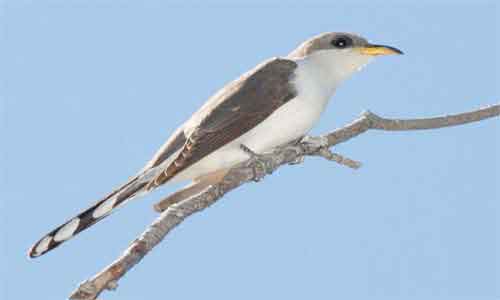

Order-15: Strigiformes (owls)
[L. Strix = Screech owl + form]
- The order Strigiformes contains 180 species in two families(Strigidae and Tytonidae.), including nocturnal birds, the owls found worldwide.
- The body size ranges from 4.7–30 inches (12–69 cm) in length.
- The birds bear soft-textured plumage and hooked beaks with strong talons.
- The head is large and round with a highly flexible neck to look sideways.
- Eyes are large and rounded with directed forward; upper eyelid is large.
- The beak is short, hooked, and sharp.
- Feet contain sharp claws, adapted for grasping.
- Ear openings are large often with a flap-like cover
- They build a nest in holes of trees or buildings. They lay white eggs in nests.
Examples: Eurasian eagle-owl (Bubo bubo), Greater sooty owl(Tyto tenebricosa), Long-eared owl (Asio otus), Northern Pygmy Owl (Claucidium Californicum) , Burrowing Owl (Speotyto cunicularia), Lesser horned owl (Bubo magellanicus), etc.
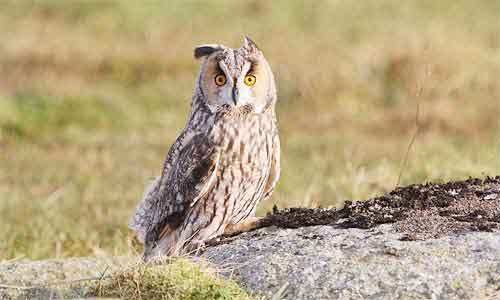

Order-16:Caprimulgiformes (nightjars)
[L. Caprimulgus = goat sucker + form]
- The order caprimulgiformes contains 121 species under 5 families including the birds group like frogmouths, potoos, and the oilbird, found worldwide.
- The size of the body ranges from 6–24 inches (15–60 cm) in length.
- They have soft plumage with small weak feet and a very largemouth.
- The bill is short, flexible with a large gape.
- Wings are long, and around the nostril, bristles are present.
- They inhabit in woods or bush and forage near ground or high in the air, and feeding insects caught in flight at night or dusk due to their nocturnal behavior.
- They lay eggs on the ground in a bush.
Examples: Tawny frogmouth (Podargus strigoides), Great potoo (Nyctibius grandis), Common Nighthawks (Chordeiles minor), European nightjar or common nightjar(Caprimulgus europaeus), Common pauraque (Nyctidromus albicollis), etc.
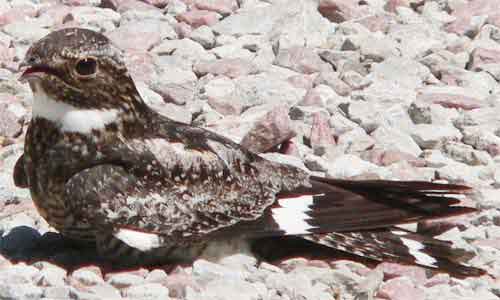

Order-17: Apodiformes (swifts, hummingbirds)
- The order Apodiformes contains approximately 425 species in three families(Apodidae, Hemiprocnidae, and Trochilidae), including the birds’ group like the swifts, treeswifts, and the hummingbirds, found worldwide.
- They are rapid-flying birds due to their forked tail that is crucial for steering the flight.
- Apodiformes feed on small insects and spiders or nectar from the flowers using tubular protrusible tongue and needle-like bill.
- The body size is either small or very small, which ranges from 2.5–9.1 inches (6.3–23 cm) in length.
- The legs are short with very small feet.
- The wings are pointed, and the bills are small and weak in swifts while in hummingbirds, it is slender with a long tubular tongue.
- The swifts have a broad mouth with large eyes.
- Predominantly, bright-colored plumage is present in hummingbirds while in swifts, the body is mostly black, grey, or brown in colors.
- Both hummingbirds and swifts build cup-like nests, and the matured females lay one or two small eggs in the nests.
- The eggs hatch after few days of incubation and produce naked and blind young chicks that develop in their nests for a long time.
Examples: Amethyst Woodstar(Calliphlox amethystine), Andean Emerald ( Agyrtria franciae), Black Inca (Coeligena prunellei). Copper-Tailed Hummingbird (Saucerottia cupreicauda), Magnificent hummingbird ( Eugenes fulgens). Jamaican Mango( Anthracothorax mango), Spot-fronted swift (Cypseloides cherriei), Sooty swift (Cypseloides fumigates), Rotschild’s swift (Cypseloides rothschildi), Indian swiftlet(Aerodramus unicolor), etc.
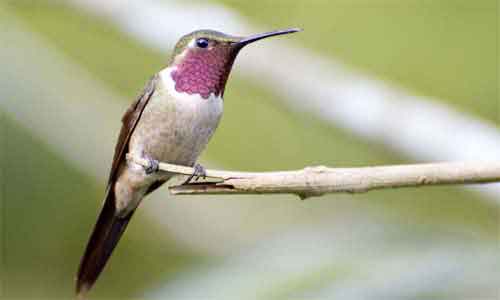

Order-18: Coliiformes (colies, or mouse-birds)
[Gk. Colius = Genus of the mouse bird + form]
- The order Coliiformes contains 6 species under 1 family ( Coliidae,)found in Africa, south of the Sahara.
- They are commonly known as colies, or mousebirds due to the presence of feathers that resemble the texture of the mouse skin.
- The body is covered with soft plumage with long, pointed tails.
- The body size ranges from 11–14 inches (29–36 cm) in length and about 45 to 55 grams in weight.
- The body is usually grey and brown in color.
- The leg is short with four toes, which are directed forward, having sharp claws for climbing on trees.
- The bills of the mouse-birds are short and stubby.
- They usually bear a crest on the head.
- They inhabit forests as well as on trees near shores and in savannas.
- The Apodiformes are monogamous/polygynous, and during the breeding season, they make a cup-shaped twig nest in trees.
- The matured female lays 2-4 tiny eggs in their nests. Both parents care for their young babies.
- The food consists of mouse-birds fruit, blossoms, seeds, and other types of vegetation.
Examples: Bar-breasted mousebirds(Colius striatus), Chestnut-backed mousebird (Colius castanotus), White-headed mousebird (Colius leucocephalus), White-backed mousebird (Colius colius), Blue-naped mousebird (Urocolius macrourus), Red-faced mousebird (Urocolius indicus).
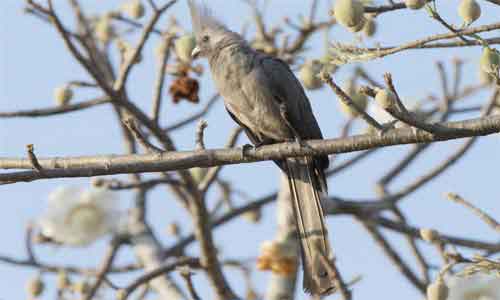

Order-19: Trogoniformes (trogons)
[Gk. Trogon = gnawing + form]
- The order Trogoniformes contains 39 species in seven genera under 1 family (Trogonidae), including the birds’ group like the trogons and quetzals; found in Asia, Africa, and Tropical America except for Australasia.
- Trogons inhabit lowland evergreen forest, pine forest, and tropical deciduous forest.
- The birds have a medium-sized body with 9.1–16 inches (23–40 cm) in length and 35 and 210 grams in weight.
- The body is covered with thin, delicate skin with soft, dense, and brightly plumage. In this case, the upper side of the body, head, breast, and back has a brilliant green with some yellow, blue, or violet while yellow, orange, pink, or carmine colors on the belly.
- The neck is short with short, heavy, broad-hooked bills and bristles at the base.
- The wings are short and rounded with long, broadly squared tails.
- The trogons have small and weak legs and feet.
- The tail is long and stiff, which supports against the vertical surface at the time of digging.
Examples: Narina trogon (Apaloderma narina), Red-naped trogon (Harpactes kasumba), Cuban trogon or tocororo (Priotelus temnurus), Mountain trogon (Trogon mexicanus), Pavonine quetzal (Pharomachrus pavoninus), and Resplendent Quetzal(Pharomachrus mocinno), etc.
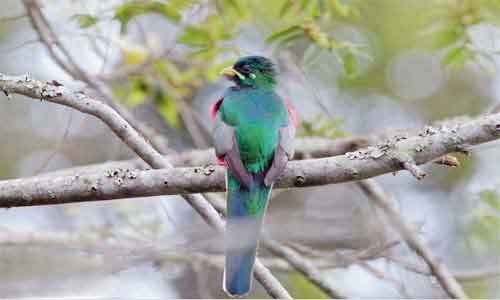

Order 20. Coraciiformes (kingfishers and their allies)
[L. Corax = raven + form]
- The order Coraciiformes contains 211 species under ten families, including the birds’ group like kingfishers, hornbills, bee-eaters, rollers, hoopoes, todies, motmots, found worldwide.
- The body is compact, and the size of the body range from about 10 cm (4 inches) to about 160 cm (about 63 inches) in length.
- The neck is short to moderately long with a large head.
- The tail is short to very long, which may be forked, square, or graduated.
- The outer or central tail feathers are pointed or spatulate at the tip.
- The wings and legs are short, and the beak is long.
- Some species have anteriorly directed toes, which are fused at the base, but in other species, one of the toes is reversed.
- Most of the birds under this order feed on invertebrates such as insects and small vertebrates, but hornbills eat berries and fruit.
- They build a nest in the tree holes.
Examples: Common kingfisher or Halcyon (Alcedo atthis), African pygmy kingfisher (Ispidina picta), Laughing kookaburra (Dacelo novaeguineae), Amazon kingfisher (Chloroceryle amazona) , Blue-headed bee-eater(Merops muelleri), Lilac-breasted roller (Coracias caudatus) , Eurasian hoopoe (Upupa epops), Great hornbill (Buceros bicornis), Oriental pied hornbill (Anthracoceros albirostris), etc.
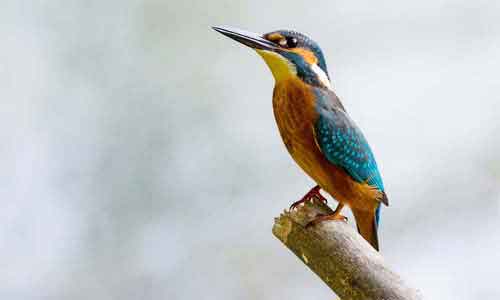

The order Coraciiformes includes the following ten families:
- Alcedinidae
- Todidae
- Momotidae
- Meropidae
- Coraciidae
- Brachypteraciidae
- Leptosomatidae
- Upupidae
- Phoeniculidae
- Bucerotidae
Order 21. Piciformes: (woodpeckers and their allies)
[L. Picus = a Woodpecker + form]
- Order Piciformes contains about 450 species under 71 living genera, including the birds’ group like jacamars, puffbirds, barbets, honeyguides, toucans, found worldwide.
- The size of the piciform species varies from about 9 to more than 60 cm (3.5 to 24 inches) in overall length.
- They inhabit the trees of forests, grassland, parks, and orchards because they are physically adapted to, easily live in trees.
- Most piciform species are insectivorous and mainly feed on insects but, they also take fruits, nuts, and other items.
- Piciformes grab insects from the cavities of trees using the long tongue. Some species use strong/heavy bills to drill holes in trees and capture the insects from the holes by long tongue.
- They have special zygodactylous feet. In this case, on each foot two of the toes point forward and the two other toes point backward which makes easy for these birds to climb up and down tree trunks.
Examples: Red-collared Woodpecker (Picus rabieri), Red-naped sapsucker (Sphyrapicus nuchalis), Toco toucan or common toucan (Ramphastos toco), Pied Puffbird (Notharcus tectus), Red-crowned Barbet (Megalaima rafflesii), etc.


The Order Piciformes includes the following eight families:
- Galbulidae
- Bucconidae
- Indicatoridae
- Picidae
- Lybiidae
- Megalaimidae
- Capitonidae
- Ramphastidae
Order-22:Passeriformes(songbirds, or perching birds)
[L. Passer = a spar-J row + form]
- Order Passeriformes contains 6,600 known species under more than 140 families.
- The order Passeriformes is the largest order of birds containing more than half of all known bird species.
- They are commonly known as perching birds or as songbirds.
- The foot bears four toes, among them three toes that point forward and one toe that point backward.
- They are small to medium-sized birds, and their size ranges from about 3 to 46 inches (7.5 to about 117 cm) in overall length.
- Bills are greatly varied in shape and sizes. In some species, it is tiny, needle-like, while in other species, it is huge, vise-like, which is designed to crack the hard shells of seeds.
Examples: Scissor-tailed flycatcher (Muscivora forficate), Rifleman (Acanthisitta chloris), Sharpbill (Oxyruncus cristatus), Superb lyrebird (Menura novaehollandiae), Red-whiskered bulbul (Pycnonotus jocosus), Loggerhead shrike (Lanius ludovicianus), Palmchat (Dulus dominicus), House crow (Corvus splendens), Common starling (Sturnus vulgaris), House sparrow (Passer domesticus), Common chaffinch (Fringilla coelebs), Fire-tailed sunbird (Aethopyga ignicauda), etc.
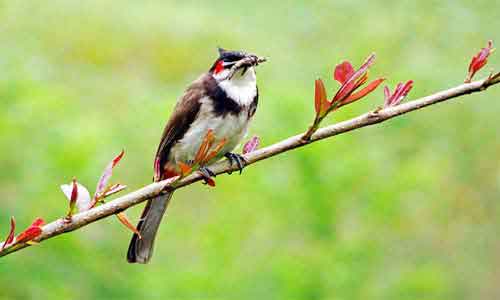

Concluding Remarks
Birds belong to subphylum Vertebrata under phylum Chordata. There are more than 10,000 living birds species under the class Aves, constituting the importance of members of many ecosystems. They make the integral parts of the food web and food chains. Many birds take their food from plants while others eat insects, earthworms, rodents, and other small vertebrates. Birds also offer food for humans by providing eggs and meat. Many birds play an essential role in cross-pollination and help in plant reproduction. At present, many birds’ species become endangered due to illegal human activities. Therefore, we should take proper conservation measures to protect them from their extinction near the future.

